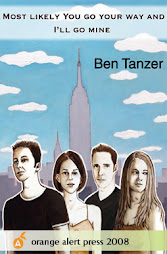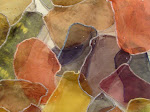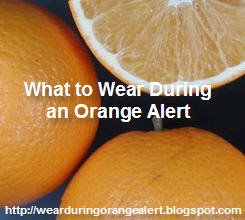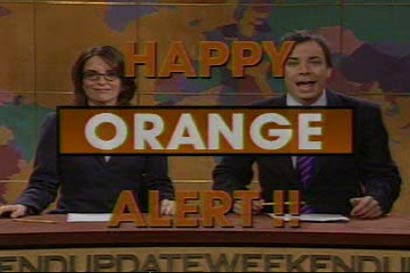Paint in its original state is a liquid, and as a liquid it is naturally prone to movement. When allowed to move and then dry the results can be very natural, free, almost alive. As the paint flows onto the canvas it searches for direction branching out exploring at will. Eventually it will dry and patterns, textures, possibly images will begin to appear. Layer upon layer, color upon color, the paints roam guided by the artists eye and imagination.
So how does the artist control this liquid while still allowing nature to play a role? In the case of New Jersey artist Jim Fuess the answer lies in the nozzle of a spray bottle. Loaded with purposefully selected paints, Jim controls the pressure, volume, direction, and area. He also paints beneath and on top of the wild paint. Forcing himself to work small also adds an element of control and limit to the direction of the paint.
Recently, Jim was kind enough to answer a few of my questions.

Orange Alert (OA): How would you describe your work
Jim Fuess (JF): I work with liquid acrylic paint on canvas. Most of my work is abstract, but there are recognizable forms and faces in a number of the paintings. I am striving for grace and balance in my paintings. A lot of his work is anthropomorphic. The shapes seem familiar. The faces are real. The gestures and movements recognizable. I believe that beauty is a valid artistic goal. I also like energy.
OA: The technique of using a squeeze bottle to change the velocity and appearance of the paint is an interesting approach. How did you first come to paint this way?
JF: Like 10 million other Americans I have Essential Tremor. I am not a photo realist or a pointillist. I use squeeze bottles for more control.I use Golden and Liquitex paint. The nozzles of the bottles vary in size as does the amount of liquidly. The variations are endless. I start with a liquid base and the other paints can be placed under, in or on top of the base.

OA: Is control an issue or not a factor? Is this why you chose to work on smaller pieces as opposed to large scale paintings?
JF: Using the bottles is very high risk. Some of the paintings run over the edge overnight or just turn brown from too much over working or too much paint.I still throw out one in four.I like to work small. Small works cost less to do and are easier to store and transport. Small works are personal rather than the grand public statement that large works make.
OA: You seem to put together a series of paintings focusing on one or two colors, and move on to the next color or colors. How do you decide what color to focus on? Do you ever use color to evoke a specific emotion in the viewer?
JF: The series of black and white paintings are an exercise in going back to the basics of form and structure. They deal with the relationship of shapes and figures to each other and to negative space.There is a long history of black and white painting. I keeps me honest rather than relying on color for effect. Color gives the work vibrancy and energy. The blue and white paintings were done because I like blue. I found Golden cobalt blue and loved what I could do with it and went a little crazy.
OA: Are the faces or forms that appear in a few of your paintings intentional? How did you first discover that there may be faces appearing?
JF: The faces and forms are mostly deliberate. Sometimes there is a surprise or something that needs encouragement.
OA: What's next for Jim Fuess?
JF: I just bought a ceiling fan with ten speeds so I can vary the drying time. I can also crack the paint in interesting ways.

Bonus questions:
OA: Coffee? If yes, what is your favorite type of coffee and where is your favorite coffee spot?
JF: I brew a combination of Starbucks caffeinated and decaf in a stove top espresso maker in the morning.
OA: Do you listen to music while you paint? Who are are a few of your favorites?
JF: No. Just the sound of the birds and the street and all of the McMansions being built all around us.
For more information on Jim Fuess please visit his website.
+by+Nick+Volkert).jpg)






















No comments:
Post a Comment